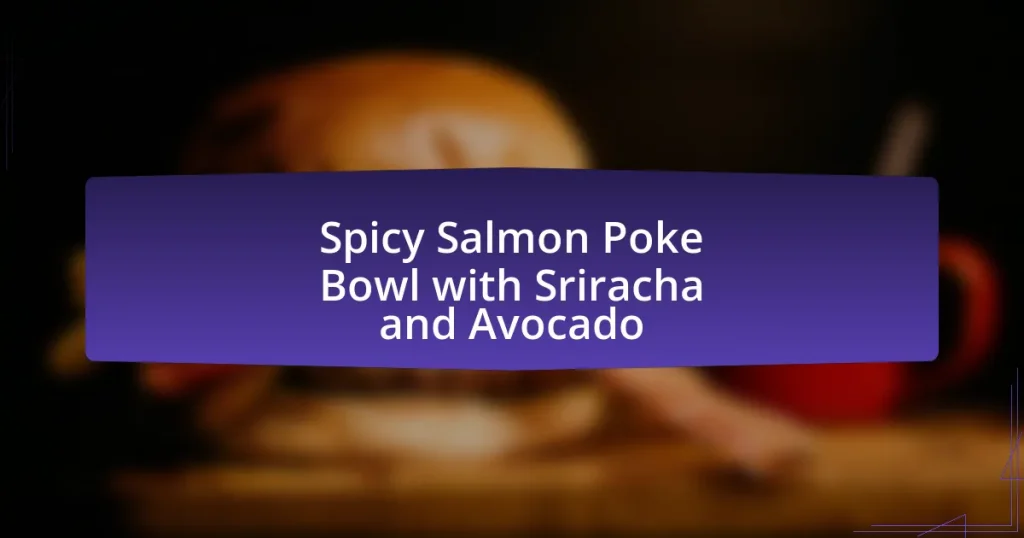A poke bowl is a customizable Hawaiian dish featuring diced raw fish, typically served over rice with various toppings and sauces. Originating from traditional Hawaiian fishing practices, poke bowls have evolved to include diverse ingredients influenced by various culinary traditions, making them popular worldwide. This article provides a comprehensive guide on how to build your own poke bowl, detailing key components such as bases, proteins, toppings, and sauces, while offering tips for effective customization to cater to individual dietary preferences and enhance flavor profiles. Additionally, it explores common mistakes to avoid and creative ideas for incorporating international flavors and seasonal ingredients into your poke bowl.

What is a Poke Bowl?
A poke bowl is a Hawaiian dish that typically consists of diced raw fish, often tuna or salmon, served over a base of rice and accompanied by various toppings and sauces. The dish originated in Hawaii and has gained popularity worldwide due to its fresh ingredients and customizable nature, allowing individuals to select their preferred fish, vegetables, and seasonings. The poke bowl’s versatility is supported by its ability to cater to diverse dietary preferences, making it a favored choice in contemporary cuisine.
How did Poke Bowls originate?
Poke bowls originated in Hawaii, where they were traditionally made by fishermen who would season the cut-offs of their catch, primarily tuna, with sea salt, seaweed, and other local ingredients. This practice dates back to the early 20th century, reflecting the cultural influences of native Hawaiian cuisine and Japanese sashimi. The term “poke” itself means “to slice” or “to cut crosswise into pieces” in Hawaiian, emphasizing the preparation method. Over time, poke bowls evolved to include a variety of toppings and bases, gaining popularity beyond Hawaii and becoming a global food trend.
What cultural influences shaped the traditional Poke Bowl?
The traditional Poke Bowl is primarily shaped by Hawaiian culture, which emphasizes fresh, local ingredients and seafood. Originating in Hawaii, poke reflects the island’s fishing traditions, where fishermen would season and cube raw fish, often using ingredients like soy sauce, sesame oil, and seaweed. The influence of Japanese cuisine is also significant, particularly in the use of sushi-grade fish and the incorporation of flavors such as wasabi and pickled vegetables. Additionally, the blending of various Asian culinary practices, including Korean and Chinese, has contributed to the diverse toppings and flavor profiles found in modern poke bowls.
How has the Poke Bowl evolved over time?
The Poke Bowl has evolved from its traditional Hawaiian roots, where it primarily consisted of raw fish, seaweed, and rice, to a more diverse and customizable dish popular worldwide. Initially, poke was a simple meal for fishermen, featuring cubed fish seasoned with sea salt and local ingredients. Over time, the dish has incorporated a variety of toppings and bases, including vegetables, fruits, and different proteins, reflecting global culinary influences. This evolution is evidenced by the rise of poke bowl restaurants in urban areas, offering a wide range of choices that cater to various dietary preferences, such as vegan and gluten-free options. The adaptation of poke bowls to include sauces, grains, and unique toppings demonstrates their transformation into a versatile meal that appeals to a broader audience.
What are the key components of a Poke Bowl?
The key components of a Poke Bowl include a base, protein, toppings, and sauce. The base typically consists of rice, quinoa, or salad greens, providing a foundation for the dish. The protein is usually raw fish such as tuna or salmon, but can also include tofu or cooked seafood. Toppings often feature a variety of vegetables, seaweed, and fruits, enhancing flavor and texture. Finally, the sauce, which can range from soy sauce to spicy mayo, adds a distinct taste to the bowl. These components collectively create a balanced and customizable meal, reflecting the traditional Hawaiian origins of poke.
What types of bases can be used in a Poke Bowl?
Poke bowls can be built on various types of bases, including sushi rice, brown rice, quinoa, and mixed greens. Sushi rice is the traditional choice, providing a sticky texture that complements the toppings. Brown rice offers a nuttier flavor and added fiber, while quinoa serves as a gluten-free alternative rich in protein. Mixed greens provide a fresh, low-carb option for those seeking a lighter meal. Each base contributes distinct nutritional benefits and flavors, allowing for customization based on dietary preferences.
What proteins are commonly included in Poke Bowls?
Common proteins included in poke bowls are raw fish varieties such as tuna, salmon, and yellowtail, as well as cooked options like shrimp, octopus, and tofu. These proteins are popular due to their flavor and nutritional value, with raw fish providing omega-3 fatty acids and cooked seafood offering a different texture and taste profile. The inclusion of these proteins aligns with traditional Hawaiian poke, which emphasizes fresh, high-quality ingredients.
What toppings enhance the flavor of a Poke Bowl?
Toppings that enhance the flavor of a Poke Bowl include avocado, seaweed salad, pickled ginger, sesame seeds, and spicy mayo. Avocado adds creaminess, while seaweed salad contributes umami and texture. Pickled ginger provides a tangy contrast, sesame seeds add a nutty crunch, and spicy mayo introduces heat and richness. These toppings not only complement the base ingredients but also create a balanced flavor profile, making the dish more enjoyable.
Why customize your Poke Bowl?
Customizing your Poke Bowl allows for a personalized dining experience that caters to individual tastes and dietary needs. By selecting specific ingredients, such as proteins, vegetables, and sauces, diners can create a meal that aligns with their flavor preferences and nutritional requirements. This customization is supported by the growing trend in the food industry towards personalized meals, as evidenced by a 2021 survey indicating that 70% of consumers prefer meals tailored to their specific dietary restrictions or preferences.
What are the benefits of personalizing your Poke Bowl?
Personalizing your Poke Bowl allows for tailored nutritional benefits and enhanced flavor preferences. By selecting specific ingredients, individuals can ensure they meet dietary needs, such as increasing protein intake or incorporating more vegetables, which can lead to improved health outcomes. For instance, customizing a Poke Bowl with lean proteins like tuna or salmon can provide essential omega-3 fatty acids, while adding a variety of vegetables can boost fiber intake. Additionally, personalization enhances the overall dining experience, as individuals can create a meal that aligns with their taste preferences, leading to greater satisfaction and enjoyment.
How does customization cater to dietary preferences?
Customization caters to dietary preferences by allowing individuals to select ingredients that align with their specific nutritional needs and tastes. This flexibility enables people to avoid allergens, adhere to dietary restrictions such as veganism or gluten-free diets, and incorporate personal flavor preferences. For example, a study published in the Journal of Nutrition found that personalized meal options significantly increase satisfaction and adherence to dietary plans, demonstrating that customization effectively meets diverse dietary requirements.

How can you effectively customize your Poke Bowl?
To effectively customize your Poke Bowl, start by selecting a base, such as sushi rice, brown rice, or mixed greens, which forms the foundation of your bowl. Next, choose a protein, like tuna, salmon, or tofu, to add flavor and nutrition. Incorporate a variety of toppings, including vegetables like avocado, cucumber, and seaweed, to enhance texture and taste. Finally, drizzle sauces such as soy sauce, spicy mayo, or ponzu to elevate the overall flavor profile. This customization process allows for a personalized meal that caters to individual preferences and dietary needs.
What are the steps to building your own Poke Bowl?
To build your own Poke Bowl, follow these steps: first, choose a base, which can be rice, quinoa, or salad greens. Next, select your protein, such as raw fish like tuna or salmon, tofu, or cooked shrimp. After that, add toppings, which may include vegetables like avocado, cucumber, or seaweed, and garnishes like sesame seeds or green onions. Finally, drizzle a sauce, such as soy sauce, spicy mayo, or ponzu, to enhance flavor. Each step allows for customization, enabling you to create a Poke Bowl that suits your taste preferences.
How do you choose the right base for your Poke Bowl?
To choose the right base for your Poke Bowl, consider your personal taste preferences and dietary needs. Common base options include sushi rice, brown rice, quinoa, and mixed greens, each offering different flavors and nutritional profiles. Sushi rice is sticky and traditional, while brown rice provides more fiber and nutrients. Quinoa is a protein-rich alternative, and mixed greens add a fresh, crunchy texture. Selecting a base that complements your chosen toppings and sauces enhances the overall flavor and experience of the Poke Bowl.
What factors should you consider when selecting proteins?
When selecting proteins for a poke bowl, consider the type of protein, its nutritional profile, and freshness. The type of protein can include options like raw fish (such as tuna or salmon), cooked seafood (like shrimp or crab), or plant-based proteins (such as tofu or tempeh). Each protein type offers different flavors and textures, impacting the overall taste of the poke bowl.
Nutritional profile is crucial; for instance, fatty fish like salmon provide omega-3 fatty acids, while tofu offers plant-based protein and is lower in calories. Freshness is vital, especially for raw fish, as it affects both taste and safety; sourcing from reputable suppliers ensures quality. These factors collectively enhance the poke bowl experience, aligning with dietary preferences and health goals.
How can you balance flavors with toppings and sauces?
To balance flavors with toppings and sauces, select complementary ingredients that enhance the overall taste profile of the poke bowl. For instance, if the base is a mild rice, adding a tangy sauce like ponzu can elevate the flavor. Incorporating toppings such as avocado provides creaminess, while crunchy elements like seaweed salad add texture. The key is to combine contrasting flavors—sweet, salty, sour, and umami—ensuring that no single element overpowers the others. This approach is supported by culinary principles that emphasize the importance of balance in flavor profiles, as seen in traditional dishes where diverse ingredients harmonize to create a cohesive taste experience.
What common mistakes should you avoid when customizing?
When customizing a poke bowl, common mistakes to avoid include overloading the bowl with too many ingredients, which can lead to a muddled flavor profile. Additionally, neglecting to balance textures and flavors, such as combining crunchy toppings with creamy sauces, can result in a less enjoyable eating experience. Failing to consider portion sizes can also lead to an unbalanced meal, where one ingredient overwhelms the others. Lastly, not paying attention to the freshness of ingredients can compromise the overall quality of the poke bowl. These mistakes can detract from the intended culinary experience and diminish the enjoyment of the dish.
How can overloading ingredients affect your Poke Bowl?
Overloading ingredients in a Poke Bowl can lead to an unbalanced flavor profile and overwhelming texture. When too many ingredients are added, the distinct tastes of each component can become muddled, making it difficult to appreciate the individual flavors. For example, a typical Poke Bowl includes a base, protein, toppings, and sauces; exceeding the recommended number of toppings can result in a chaotic mix that detracts from the overall experience. Additionally, an overloaded bowl may become difficult to eat, as the ingredients can spill over or mix in ways that make it challenging to enjoy each bite.
What should you know about ingredient freshness and quality?
Ingredient freshness and quality are crucial for creating a delicious poke bowl. Fresh ingredients enhance flavor, texture, and nutritional value, while high-quality components ensure food safety and overall satisfaction. For instance, fish should be sushi-grade, meaning it has been frozen to eliminate parasites, and vegetables should be vibrant and crisp, indicating they are recently harvested. Studies show that fresh produce retains more vitamins and minerals, which contributes to a healthier meal. Therefore, selecting the freshest and highest quality ingredients directly impacts the taste and health benefits of your poke bowl.

What are some creative ideas for Poke Bowl customization?
Creative ideas for Poke Bowl customization include using unique bases like quinoa or cauliflower rice, incorporating diverse proteins such as marinated tofu or seared scallops, and adding unexpected toppings like pickled ginger or spicy kimchi. These options enhance flavor and texture, allowing for a personalized dining experience. For instance, quinoa offers a nutty flavor and additional protein, while pickled ginger adds a tangy contrast to the dish.
How can you incorporate international flavors into your Poke Bowl?
To incorporate international flavors into your Poke Bowl, use ingredients and seasonings from various cuisines. For example, add kimchi for a Korean twist, use sriracha or hoisin sauce for a Southeast Asian flavor, or incorporate Mediterranean olives and feta cheese. These ingredients not only enhance the taste but also reflect the culinary diversity found in global dishes, allowing for a unique and flavorful Poke Bowl experience.
What unique toppings can elevate your Poke Bowl experience?
Unique toppings that can elevate your Poke Bowl experience include crispy garlic, wasabi peas, and mango salsa. Crispy garlic adds a savory crunch, while wasabi peas introduce a spicy kick, enhancing the overall flavor profile. Mango salsa contributes a sweet and tangy element, balancing the dish’s richness. These toppings not only provide diverse textures and flavors but also create a more memorable and satisfying meal.
How can seasonal ingredients inspire your Poke Bowl choices?
Seasonal ingredients can inspire your Poke Bowl choices by enhancing flavor, freshness, and nutritional value. Utilizing ingredients that are in season, such as ripe avocados in summer or hearty root vegetables in winter, ensures that the components of your bowl are at their peak taste and quality. For example, seasonal fruits like mango or strawberries can add a sweet contrast to savory elements, while vegetables like radishes or asparagus can provide crunch and color. This approach not only supports local agriculture but also allows for a diverse and dynamic menu that changes throughout the year, keeping your Poke Bowl experience exciting and aligned with the natural growing cycles.
What are some popular Poke Bowl combinations to try?
Popular poke bowl combinations include Ahi tuna with avocado, seaweed salad, and spicy mayo; salmon with mango, cucumber, and sesame dressing; and tofu with edamame, carrots, and ponzu sauce. These combinations are favored for their balance of flavors and textures, appealing to a wide range of tastes. The use of fresh ingredients like fish and vegetables enhances the nutritional value, making these combinations not only delicious but also healthy options.
What classic combinations are favored by Poke Bowl enthusiasts?
Poke Bowl enthusiasts favor classic combinations such as Ahi tuna with avocado and seaweed salad, salmon with mango and cucumber, and spicy tuna with edamame and scallions. These combinations are popular due to their balance of flavors and textures, enhancing the overall poke bowl experience. The use of fresh ingredients like fish, vegetables, and toppings aligns with traditional Hawaiian poke, which emphasizes quality and freshness.
How can you create a themed Poke Bowl for special occasions?
To create a themed Poke Bowl for special occasions, select a specific theme that resonates with the event, such as a holiday, cultural celebration, or color scheme. For example, for a Hawaiian luau theme, incorporate traditional ingredients like ahi tuna, seaweed salad, and tropical fruits such as mango and pineapple. Additionally, use vibrant toppings like edible flowers or colorful vegetables to enhance the visual appeal and align with the theme. This approach not only personalizes the dish but also engages guests, making the meal memorable. Themed Poke Bowls can elevate the dining experience by reflecting the occasion’s spirit through carefully chosen ingredients and presentation.
What tips can enhance your Poke Bowl customization experience?
To enhance your Poke Bowl customization experience, focus on balancing flavors, textures, and nutritional value. Selecting a variety of proteins, such as tuna, salmon, or tofu, allows for diverse taste profiles. Incorporating a mix of toppings like avocado, seaweed, and pickled vegetables adds both texture and flavor complexity. Additionally, choosing a base of rice, quinoa, or greens can provide a nutritious foundation. Finally, experimenting with sauces, such as spicy mayo or soy sauce, can elevate the overall taste. These strategies ensure a well-rounded and satisfying Poke Bowl that caters to personal preferences.



